In the Eye of the Beholder: Owner Preferences for Variations in Cats’ Appearances with Specific Focus on Skull Morphology
Abstract
:Simple Summary
Abstract
1. Introduction
2. Materials and Methods
2.1. Recruitment of Participants and Questions Asked
2.2. Establishing Cephalic Rating for Analyses
2.3. Assigning Coat Color for Analyses
2.4. Statistical Analyses
3. Results
3.1. Response Rates and Descriptive Statistics
3.2. Cephalic Rating Consensus
3.3. Associations between Phenotypic Features and Rating Score
3.4. Factors Associated with BC Cat Ratings
3.5. Factors Associated with DC Cat Ratings
4. Discussion
5. Conclusions
Supplementary Materials
Acknowledgements
Author Contributions
Conflict of interest
References
- Hu, Y.; Hu, S.; Wang, W.; Wu, X.; Marshall, F.B.; Chen, X.; Hou, L.; Wang, C. Earliest evidence for commensal processes of cat domestication. Proc. Natl. Acad. Sci. USA 2014, 111, 116–120. [Google Scholar] [CrossRef] [PubMed]
- Montague, M.J.; Li, G.; Gandolfi, B.; Khan, R.; Aken, B.L.; Searle, S.M.; Minx, P.; Hillier, L.M.; Koboldt, D.C.; Davis, B.W.; et al. Comparative analysis of the domestic cat genome reveals genetic signatures underlying feline biology and domestication. Proc. Natl. Acad. Sci. USA 2014, 111, 17230–17235. [Google Scholar] [CrossRef] [PubMed] [Green Version]
- Merola, I.; Lazzaroni, M.; Marshall-Pescini, S.; Prato-Previde, E. Social referencing and cat-human communication. Anim. Cog. 2015, 18, 639–648. [Google Scholar] [CrossRef] [PubMed]
- Cieslak, M.; Reissmann, M.; Hofreiter, M.; Ludwig, A. Colours of domestication. Biol. Rev. Camb. Philos. Soc. 2011, 86, 885–899. [Google Scholar] [CrossRef] [PubMed]
- Kurushima, J.D.; Lipinski, M.J.; Gandolfi, B.; Froenicke, L.; Grahn, J.C.; Grahn, R.A.; Lymons, L.A. Variation of cats under domestication: Genetic assignment of domestic cats to breeds and world-wide random bred populations. Anim. Genet. 2013, 44, 311–324. [Google Scholar] [CrossRef] [PubMed]
- Murray, J.K.; Gruffydd-Jones, T.J. Proportion of pet cats registered with a veterinary practice and factors influencing registration in the UK. Vet. J. 2012, 192, 461–466. [Google Scholar] [CrossRef] [PubMed]
- O’Neill, D.G.; Church, D.B.; McGreevy, P.D.; Thomson, P.C.; Brodbelt, D.C. Prevalence of disorders recorded in cats attending primary-care veterinary practices in England. Vet. J. 2014, 202, 286–291. [Google Scholar] [CrossRef] [PubMed]
- Hirschman, E.C. Consumers and their animal companions. J. Consum. Res. 1994, 20, 617–632. [Google Scholar] [CrossRef]
- Clark, J.M. The effects of selection and human preference on coat colour gene frequencies in urban cats. Heredity 1975, 35, 195–210. [Google Scholar] [CrossRef] [PubMed]
- Lepper, M.; Kass, P.H.; Hart, L.A. Prediction of adoption versus euthanasia among dogs and cats in a California animal shelter. J. Appl. Anim. Welf. Sci. 2002, 5, 29–42. [Google Scholar] [CrossRef] [PubMed]
- Brown, W.P.; Morgan, T.M. Age, breed designation, coat colour and coat pattern influenced the length of stay of cats at a no-kill shelter. J. Appl. Anim. Welf. Sci. 2015, 18, 169–180. [Google Scholar] [CrossRef] [PubMed]
- Caeiro, C.C.; Burrows, A.M.; Waller, B.M. Development and application of CatFACS: Are human adopters influenced by cat facial expressions? Appl. Anim. Behav. Sci. 2017, 189, 66–78. [Google Scholar] [CrossRef]
- Ghirlanda, S.; Acerbi, A.; Herzog, H. Dog movie stars and dog breed popularity: A case study in media influence on choice. PLoS ONE 2014, 9, e106565. [Google Scholar] [CrossRef] [PubMed]
- Herzog, H.A. Forty-two thousand and one Dalmatians: Fads, social contagion and dog breed popularity. Soc. Anim. 2006, 14, 383–398. [Google Scholar] [CrossRef]
- Packer, R.M.A.; Murphy, D.; Farnworth, M.J. Purchasing popular purebreds: investigating the influence of breed-type on the pre-purchase motivations and behaviour of dog owners. Anim. Welf. 2017, 26, 191–201. [Google Scholar] [CrossRef]
- The Cat Fanciers Association. Available online: http://www.cfa.org/AboutCFA/News/PressReleases/PressRelease2017Top10Breeds2016.aspx (accessed on 21 September 2017).
- Roedler, F.S.; Pohl, S.; Oechtering, G.U. How does severe brachycephaly affect dog’s lives? Results of a structured preoperative owner questionnaire. Vet. J. 2013, 198, 606–610. [Google Scholar] [CrossRef] [PubMed]
- Packer, R.M.A.; Hendricks, A.; Burn, C.C. Do dog owners perceive the clinical signs related to conformational inherited disorders as “normal” for the breed? A potential constraint to improving canine welfare. Anim. Welf. 2012, 21, 81–93. [Google Scholar] [CrossRef]
- Farnworth, M.J.; Chen, R.; Packer, R.M.A.; Caney, S.M.A.; Gunn-Moore, D.A. Flat feline faces: Is brachycephaly associated with respiratory abnormalities in the domestic cat (Felis catus)? PLoS ONE 2017, 11, e0161777. [Google Scholar] [CrossRef] [PubMed]
- Kunzel, W.; Breit, S.; Oppel, M. Morphological characteristics of the paranasal sinuses in brachycephalic cats and their functional relevance. Wien Tierarztl Monatsschr 2002, 89, 334–340. [Google Scholar]
- Ginn, J.A.; Kumar, M.S.A.; McKiernan, B.C.; Powers, B. Nasopharyngeal turbinates in brachycephalic dogs and cats. J. Am. Anim. Hosp. Assoc. 2008, 44, 243–249. [Google Scholar] [CrossRef] [PubMed]
- Blocker, T.; van der Woerdt, A. A comparison of coreneal sensitivity between brachycephalic and Domestic Short-haired cats. Vet. Opthalmol. 2001, 4, 127–130. [Google Scholar] [CrossRef]
- Kafarnik, C.; Fritsche, J.; Reese, S. Corneal innervation in mesocephalic and brachycephalic dogs and cats: Assessment using in vivo confocal microscopy. Vet. Opthalmol. 2008, 11, 363–367. [Google Scholar] [CrossRef] [PubMed]
- Häußler, T.C.; von Puckler, K.H.; Thiel, C.; Failing, K.; Ondreka, N.; Kramer, M.; Schmidt, M.J. Measurement of the normal pituitary gland in brachycephalic and mesocephalic cats. J. Feline Med. Surg. 2017. [Google Scholar] [CrossRef] [PubMed]
- Schmidt, M.J.; Kampschulte, M.; Enderlein, S.; Gorgas, D.; Lang, J.; Ludewig, E.; Fischer, A.; Meyer-Lindenberg, A.; Schaubmar, A.R.; Failing, K.; Ondreka, N. The relationship between brachycephalic head features in modern persian cats and dysmorphologies of the skull and internal hydrocephalus. J. Vet. Intern. Med. 2017, 31, 1487–1501. [Google Scholar] [CrossRef] [PubMed]
- Huizing, X.; Sparkes, A.; Dennis, R. Shape of the feline cerebellum and occipital bone related to breed on MRI of 200 cats. J. Feline Med. Surg. 2017, 19, 1065–1072. [Google Scholar] [CrossRef] [PubMed]
- Graham, K.L.; White, J.D.; Billson, F.M. Feline corneal sequestra: Outcome of corneoconjunctival transposition in 97 cats (109 eyes). J. Feline Med. Surg. 2017, 19, 710–716. [Google Scholar] [CrossRef] [PubMed]
- Bayat, M.; Momen-Haravi, F.; Marjani, M.; Motahhary, P. A comparison of bone reconstruction following application of bone matrix gelatin and autogenous bone grafts to alveolar defects: An animal study. J. Craniomaxillofac Surg. 2010, 38, 288–292. [Google Scholar] [CrossRef] [PubMed]
- Corgozinho, K.B.; Pereira, A.N.; Cunha, S.C.; Damico, C.B.; Ferreira, A.M.; de Souza, H.J. Recurrent pulmonary edema secondary to elongated soft palate in a cat. J. Feline Med. Surg. 2012, 14, 417–419. [Google Scholar] [CrossRef] [PubMed]
- Trostel, C.; Frankel, D.J. Punch resection alaplasty technique in dogs and cats with stenotic nares: 14 cases. J. Am. Anim. Hosp. Assoc. 2010, 46, 5–11. [Google Scholar] [CrossRef] [PubMed]
- O’Neill, D.G.; Church, D.B.; McGreevy, P.D.; Thomson, B.C.; Brodbelt, D.C. Longevity and mortality of cats attending primary care veterinary practices in England. J. Feline Med. Surg. 2015, 17, 125–133. [Google Scholar] [CrossRef] [PubMed]
- Keyes, M. Brachycephalic cats―Is it too late for the Persian? J. Feline Med. Surg. 2010, 12, 55. [Google Scholar] [CrossRef] [PubMed]
- Malik, R.; Sparkes, A.; Bessant, C. Brachycephalia––A bastardisation of what makes cats special. J. Feline Med. Surg. 2009, 11, 889–890. [Google Scholar] [CrossRef] [PubMed]
- Campbell, F.E.; Thomas, W.P. Congenital supravalvular mitral stenosis in 14 cats. J. Vet. Cardiol. 2012, 14, 281–292. [Google Scholar] [CrossRef] [PubMed]
- Padnick-Silver, L.; Kang Derwent, J.J.; Giuliano, E.; Narfström, K.; Lisenmeier, R.A. Retinal oxygenation and oxygen metabolism in Abyssinian cats with hereditary retinal degeneration. Invest. Ophthalmol. Vis. Sci. 2006, 47, 3683–3689. [Google Scholar] [CrossRef] [PubMed]
- Farrow, T.; Keown, A.J.; Farnworth, M.J. An exploration of attitudes towards pedigree dogs and their disorders as expressed by a sample of companion animal veterinarians in New Zealand. N. Z. Vet. J. 2014, 62, 267–273. [Google Scholar] [CrossRef] [PubMed]
- Maggitti, P. The pug dog’s origin. In Pugs: A Complete Pet Owner’s Manual, 3rd ed.; Barron’s Educational Series Inc.: New York, NY, USA, 2010; p. 10. [Google Scholar]
- Lipinski, M.J.; Froenicke, L.; Baysac, K.C.; Billings, N.C.; Leutenegger, C.M.; Levy, A.M.; Longeri, M.; Niini, T.; Ozpinar, H.; Slater, M.R.; Pedersen, N.C.; Lyons, L.A. The ascent of cat breeds: Genetic evaluations of breeds and worldwide random-bred populations. Genomics 2008, 91, 12–21. [Google Scholar] [CrossRef] [PubMed]
- Bettman, J.R.; Park, C.W. Effects of prior knowledge and experience and phase of the choice on consumer decision making processes: A protocol analysis. J. Consumer Res. 1980, 7, 234–248. [Google Scholar] [CrossRef]
- Delgado, M.M.; Munera, J.D.; Reevy, G.M. Human perceptions of coat color as an indicator of domestic cat personality. Anthrozoös 2012, 25, 427–440. [Google Scholar] [CrossRef]
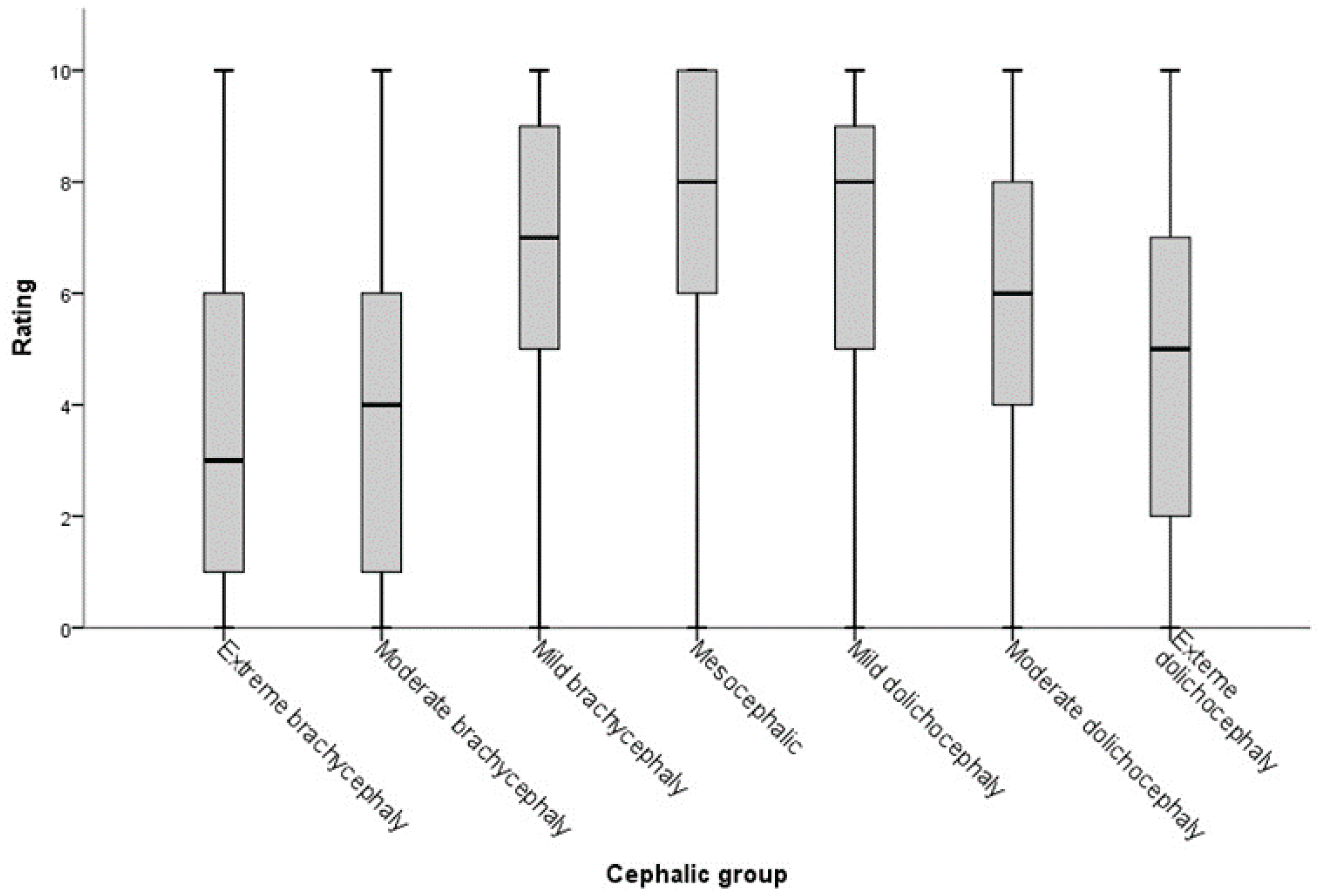
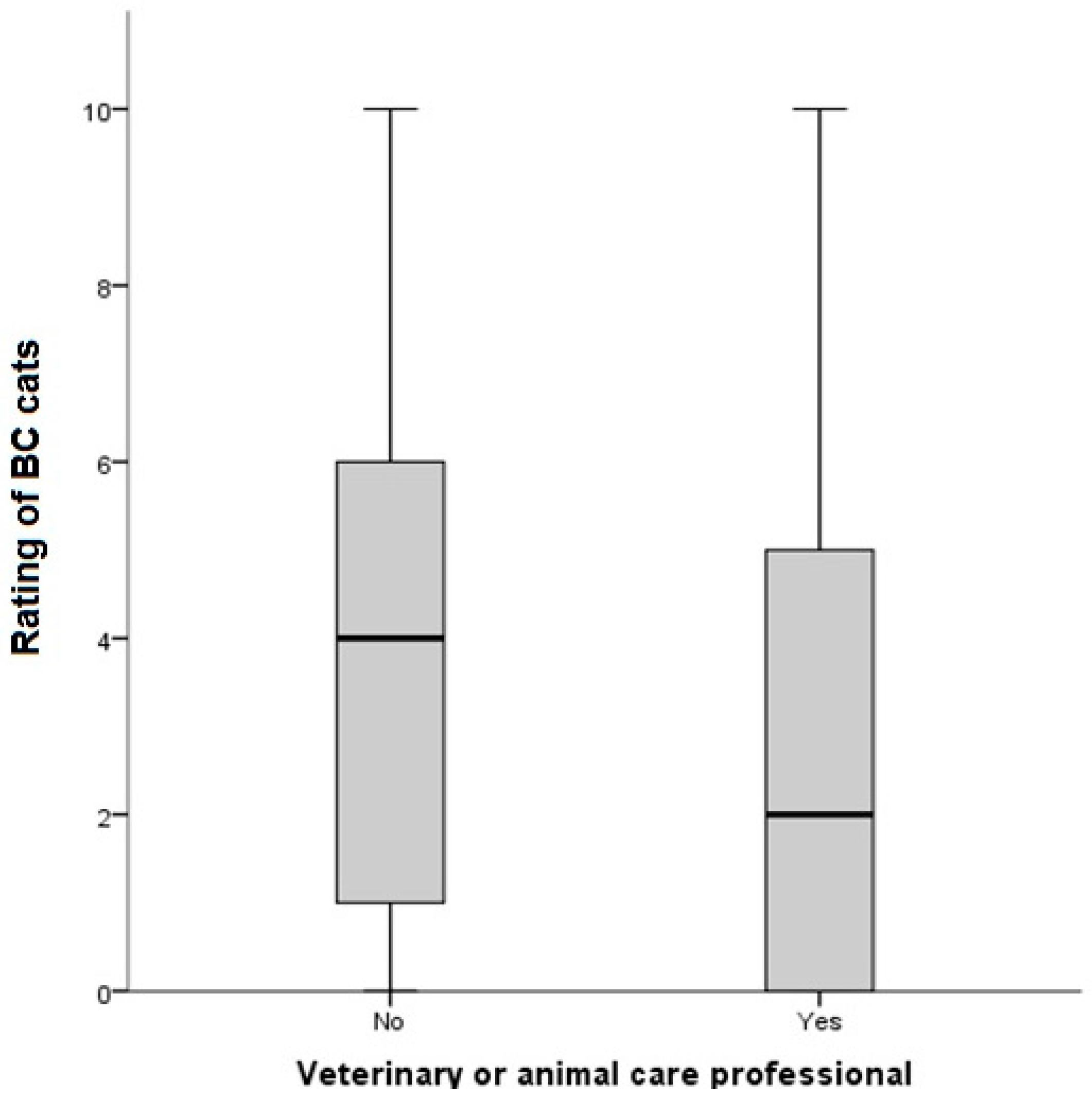
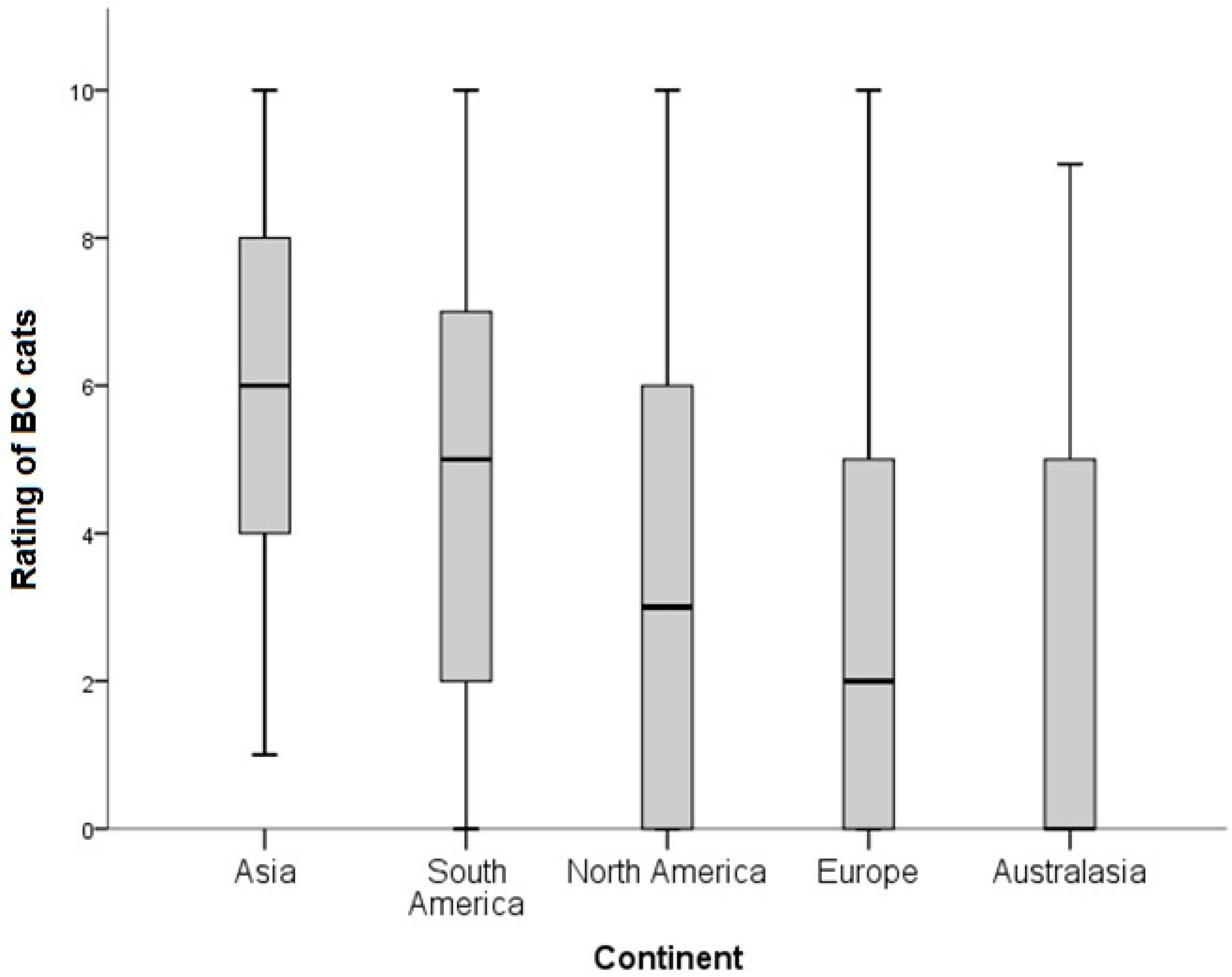
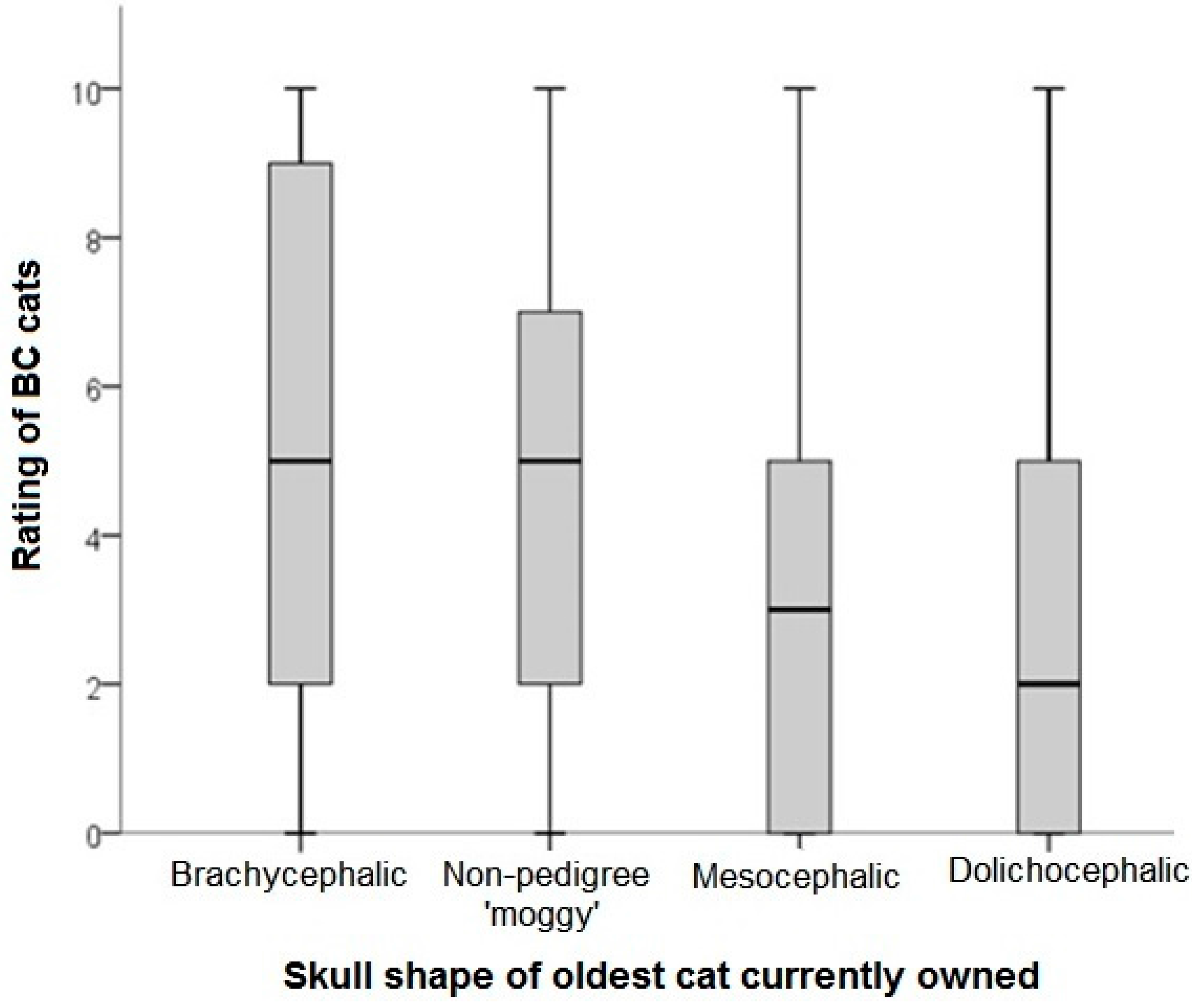
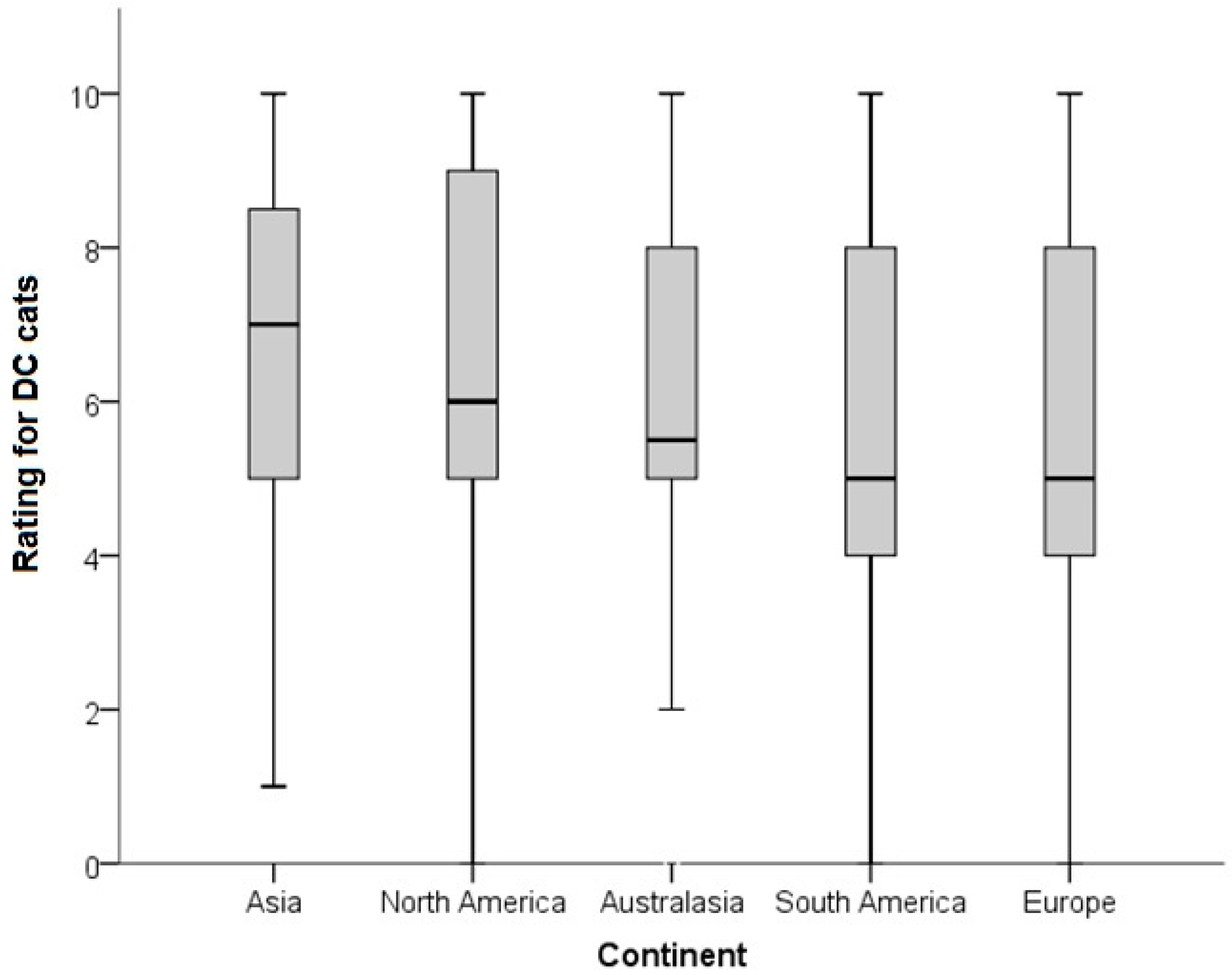
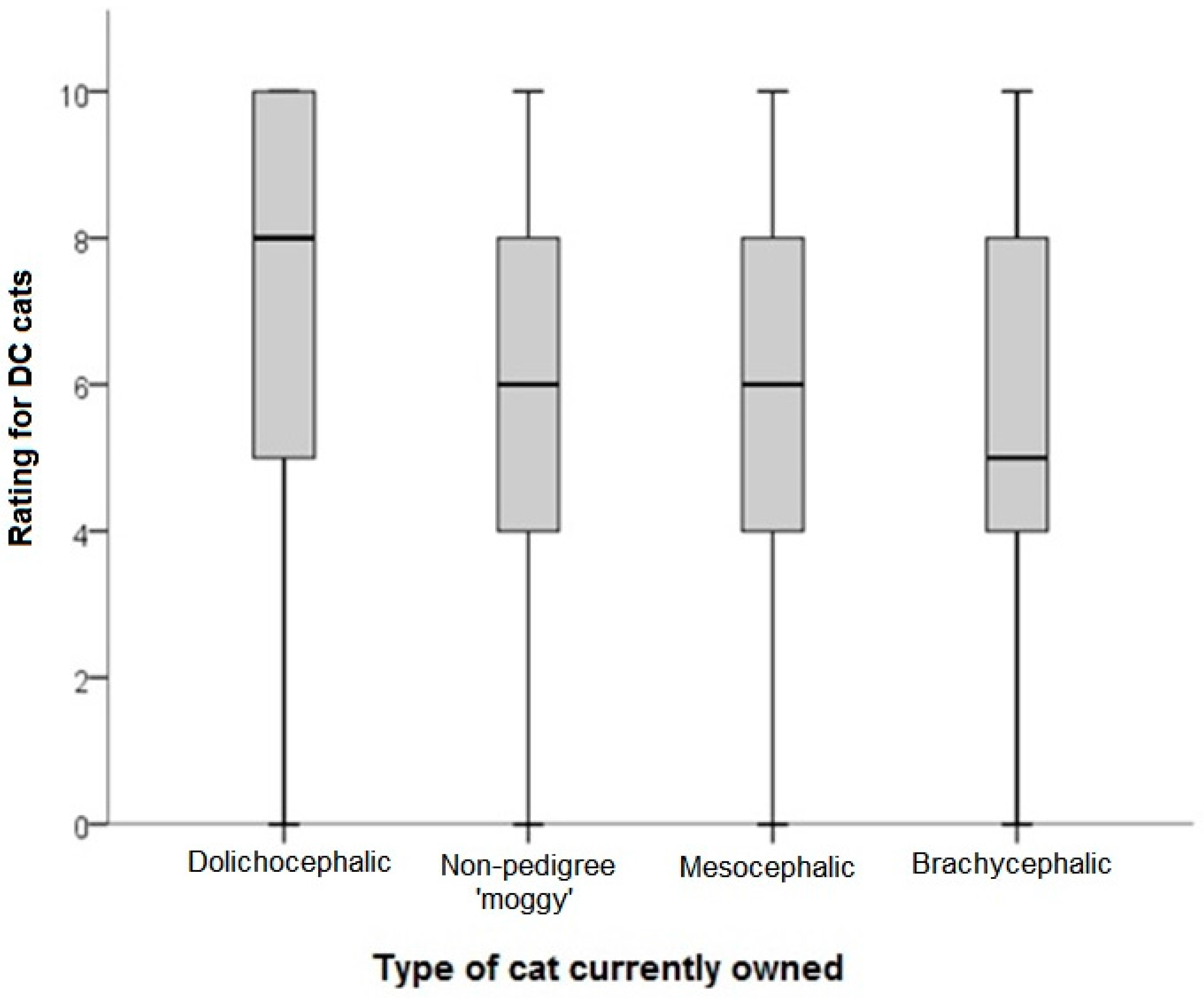
| Cat Number | Number of Responses | Mean Rating (1–7) | Median Rating (1–7) | Modal Rating (1–7) | Max Rating (1–7) | Min Rating (1–7) |
|---|---|---|---|---|---|---|
 | 50 | 1.6 | 2 | 2 | 2 | 1 |
 | 50 | 4.3 | 4 | 4 | 6 | 4 |
 | 50 | 4.8 | 5 | 5 | 7 | 3 |
 | 50 | 3.8 | 4 | 4 | 6 | 3 |
 | 50 | 5.7 | 6 | 6 | 7 | 5 |
 | 50 | 1.3 | 1 | 1 | 2 | 1 |
 | 50 | 4.6 | 4 | 4 | 7 | 3 |
 | 50 | 1.1 | 1 | 1 | 2 | 1 |
 | 50 | 3.0 | 3 | 3 | 4 | 2 |
 * * | 47 | 1.9 | 2 | 2 | 3 | 1 |
 * * | 47 | 6.6 | 7 | 7 | 7 | 5 |
 * * | 47 | 1.4 | 1 | 1 | 2 | 1 |
 * * | 46 | 6.2 | 6 | 6 | 7 | 4 |
 * * | 46 | 4.1 | 4 | 4 | 6 | 3 |
 * * | 45 | 1.0 | 1 | 1 | 2 | 1 |
| Variable | Sub-Category | Median Rating | 25th–75th Percentile Rating | Kruskal-Wallis Statistic | Kruskal-Wallis Statistic | p-Value |
|---|---|---|---|---|---|---|
| Coat length | Long | 5 | 2–7 | 506.8 | <0.001 | |
| Medium | 7 | 5–9 | ||||
| Short | 6 | 3–8 | ||||
| Coat colour | Blue grey | 6 | 3–8 | 256.7 | <0.001 | |
| Ginger | 6 | 4–9 | ||||
| Tabby | 5 | 2–9 | ||||
| White/Pale/Point | 4 | 1–7 | ||||
| Eye colour | Blue | 5 | 1–8 | 348.4 | <0.001 | |
| Green | 6 | 4–9 | ||||
| Orange or Brown | 5 | 2–8 | ||||
| Cephalic group | Extreme brachycephaly | 3 | 1–6 | 4021.9 | <0.001 | |
| Moderate brachycephaly | 4 | 1–8 | ||||
| Mild brachycephaly | 7 | 5–9 | ||||
| Mesocephaly | 8 | 6–10 | ||||
| Mild dolichocephaly | 8 | 5–9 | ||||
| Moderate dolichocephaly | 6 | 4–8 | ||||
| Extreme dolichocephaly | 5 | 2–7 |
| Variable | Sub-Category | Regression Statistic (B) | Standard Error (SE) | 95% Confidence interval (CI) | Wald | p |
|---|---|---|---|---|---|---|
| Intercept | - | 1.93 | 0.44 | 1.05–2.80 | 18.89 | <0.001 |
| Cephalic group | Extreme BC | −2.99 | 0.12 | −3.22–−2.76 | 649.47 | <0.001 |
| Moderate BC | −4.59 | 0.12 | −4.82–−4.37 | 1541.88 | <0.001 | |
| Mild BC | −1.03 | 0.09 | −1.22–−0.83 | 106.36 | <0.001 | |
| Mesocephalic | Reference | |||||
| Mild DC | −4.63 | 0.39 | −5.39–−3.87 | 143.60 | <0.001 | |
| Moderate DC | 0.31 | 0.21 | −0.10–0.72 | 2.15 | 0.142 | |
| Extreme DC | −0.87 | 0.23 | −1.32–−0.44 | 15.18 | <0.001 | |
| Coat length | Long | 3.48 | 0.21 | 3.07–3.89 | 272.03 | <0.001 |
| Medium | 1.63 | 0.16 | 1.31–1.95 | 101.25 | <0.001 | |
| Short | Reference | |||||
| Eye color | Blue | 3.63 | 0.36 | 2.94–4.33 | 104.17 | <0.001 |
| Green | 1.85 | 0.17 | 1.52–2.18 | 123.12 | <0.001 | |
| Orange or Brown | Reference | |||||
| Coat color | Blue grey | 3.76 | 0.31 | 3.14–4.37 | 143.59 | <0.001 |
| Ginger | 6.34 | 0.46 | 5.43–7.24 | 188.33 | <0.001 | |
| Tabby | 4.61 | 0.38 | 3.89–5.33 | 157.10 | <0.001 | |
| White/pale/point | Reference | |||||
| Variable | Sub-Category | Regression Statistic (B) | Standard Error (SE) | 95% Confidence Interval (CI) | Wald | p |
|---|---|---|---|---|---|---|
| Intercept | - | 5.81 | 0.61 | 5.69–5.93 | 9072.47 | <0.001 |
| Animal care profession | No | 0.70 | 0.08 | 0.54–0.87 | 71.33 | <0.001 |
| Yes | Reference | |||||
| Continent | Asia | 0.86 | 0.15 | 0.57–1.43 | 34.02 | <0.001 |
| Australasia | −2.31 | 0.29 | −2.88–−1.74 | 62.50 | <0.001 | |
| North America | −0.89 | 0.17 | −1.22–−0.56 | 27.79 | <0.001 | |
| Europe | −1.73 | 0.14 | −2.01–−1.45 | 144.74 | <0.001 | |
| South America | Reference | |||||
| Currently reported cat type | BC | 1.18 | 0.11 | 0.97–1.40 | 112.72 | <0.001 |
| DC | −0.56 | 0.16 | −0.89–−0.23 | 11.31 | 0.001 | |
| Mesocephalic | −0.19 | 0.78 | −0.35–−0.41 | 6.18 | 0.013 | |
| Non-pedigree | Reference | |||||
| Variable | Sub-Category | Regression Statistic (B) | Standard Error (SE) | 95% Confidence Interval (CI) | Wald | p |
|---|---|---|---|---|---|---|
| Intercept | - | 5.69 | 0.17 | 5.35–6.02 | 1104.30 | <0.001 |
| Continent | Asia | 1.01 | 0.20 | 0.61–1.41 | 24.63 | <0.001 |
| Australasia | 0.03 | 0.33 | −0.61–0.68 | 0.009 | 0.924 | |
| North America | 0.28 | 0.21 | −0.12–0.69 | 1.87 | 0.172 | |
| Europe | −0.11 | 0.20 | 0.61–1.41 | 24.63 | <0.001 | |
| South America | Reference | |||||
| Currently reported cat type | BC | −0.15 | 0.15 | −0.44–0.15 | 0.98 | 0.323 |
| DC | 1.75 | 0.21 | 1.34–2.16 | 69.87 | <0.001 | |
| Mesocephalic | 0.15 | 0.11 | −0.06–0.36 | 1.89 | 0.169 | |
| Non-pedigree | Reference | |||||
© 2018 by the authors. Licensee MDPI, Basel, Switzerland. This article is an open access article distributed under the terms and conditions of the Creative Commons Attribution (CC BY) license (http://creativecommons.org/licenses/by/4.0/).
Share and Cite
Farnworth, M.J.; Packer, R.M.A.; Sordo, L.; Chen, R.; Caney, S.M.A.; Gunn-Moore, D.A. In the Eye of the Beholder: Owner Preferences for Variations in Cats’ Appearances with Specific Focus on Skull Morphology. Animals 2018, 8, 30. https://doi.org/10.3390/ani8020030
Farnworth MJ, Packer RMA, Sordo L, Chen R, Caney SMA, Gunn-Moore DA. In the Eye of the Beholder: Owner Preferences for Variations in Cats’ Appearances with Specific Focus on Skull Morphology. Animals. 2018; 8(2):30. https://doi.org/10.3390/ani8020030
Chicago/Turabian StyleFarnworth, Mark J., Rowena M. A. Packer, Lorena Sordo, Ruoning Chen, Sarah M. A. Caney, and Danièlle A. Gunn-Moore. 2018. "In the Eye of the Beholder: Owner Preferences for Variations in Cats’ Appearances with Specific Focus on Skull Morphology" Animals 8, no. 2: 30. https://doi.org/10.3390/ani8020030







